Here is the Volume 3 of American Football from When you watch something, visit us first! Mr. Yorihisa SEKIGUCHI, former Head Coach of the “ThreeNailsCrowns “, the American Football team of J.F.Oberlin University told us about the plays of Offense (OF) of American Football. This is the complete version of Part 3-1 and 3-2 on our YouTube channel.
In the American Football Vol.2, we learned the characteristics and roles of each position.
Mr. Yorihisa SEKIGUCHI, former Head Coach of “Three Nails Crowns, the American Football team of J. F. Oberlin University, told us again about the plays of Offense (OF).
-1024x576.png)
Part3-1 Formation of Offense (OF) and major plays
Formation of Offense (OF)
Now, let’s see the formation of OF.
Basically, these 5 Offensive Line (OL), 1 Quarter Back (QB), and 1 Running Back (RB) are assigned in almost every formations.

If one team wants to make Run Play more effective, it is considerable to include more large players who are good at blocking.
There are 2 RB and 2 Tight Ends (TE), therefore, this formation is called “22 Personnel.”

As this formation has only 1 Wide Receiver (WR) who can be the main target of Passes, even though TE can also be, and it also contains RB and Full Back (FB), and 2 TE, therefore, it is a very Run-heavy formation, naturally, Defense (DF) players also gather near the ball.
Q: When and by what can DF suppose that this formation is Run heavy?
If there are many large players, such as TE, at the huddle, DF will determine that OF is likely to do Run Play, and prepare for it.
This OF formation will allow them Run Play to be effective, but DF will also be defended mainly for it.
Of course, there are few OF that don’t do Pass Play, so the orthodox formation is with 2 RB and 1 TE, which commonly referred to as “21 Personnel.”

I think this is a balanced formation, but it still has a high tendency for Run Play.
The mainstream formation now contains 1 TE and 1 RB, which called “11 Personnel.”

With 11 Personnels, there will automatically be 3 WR. This formation is probably the most commonly done.
And, there is a formation in which QB takes Snap from Center (C) just behind C, and “Shotgun” formation in which QB takes Snap away from C.
Major play of Offense (OF) ① (Screen Play)
A short pass behind the opponent’s back is called a “Screen Play.” I will explain what kind of play it is with a simple example.
For example, if it is 3rd Down &10 yards to go, most DF players assume Pass. In that case, Defensive Linemen (DL) will come in hard for QB sack.
At such times, if all WR run into Deep zone, Defensive Backs (DB, i.e. Corner Back (CB) and Safety (S)) will also drop back. By doing this, a large space is created here.
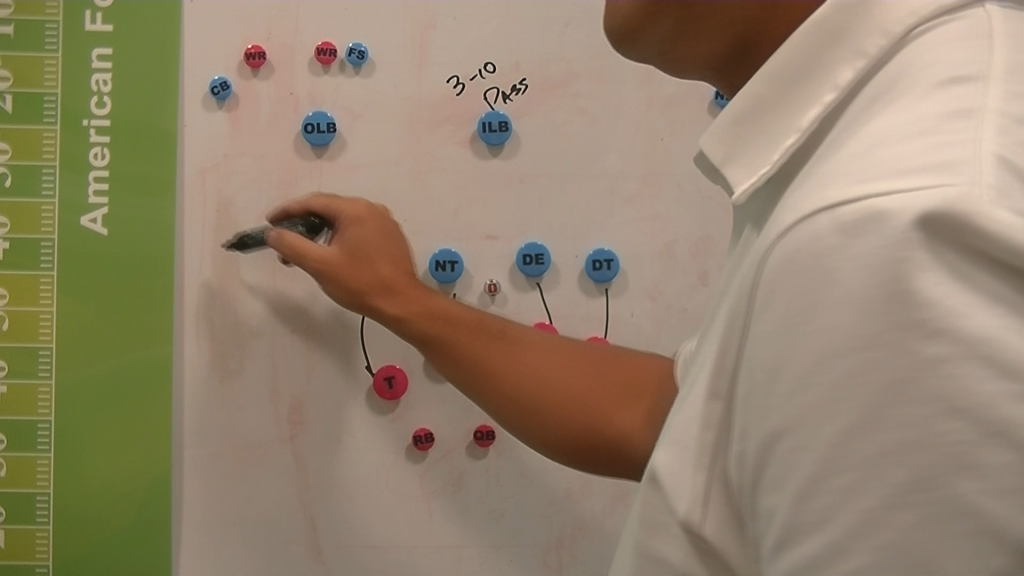
When DF is rushing and QB is under pressure, RB will get into behind DF and throw a very short pass, and these players will become blockers.
Such a play is called “Screen Pass (Screen Play)” because they are like a screen here.
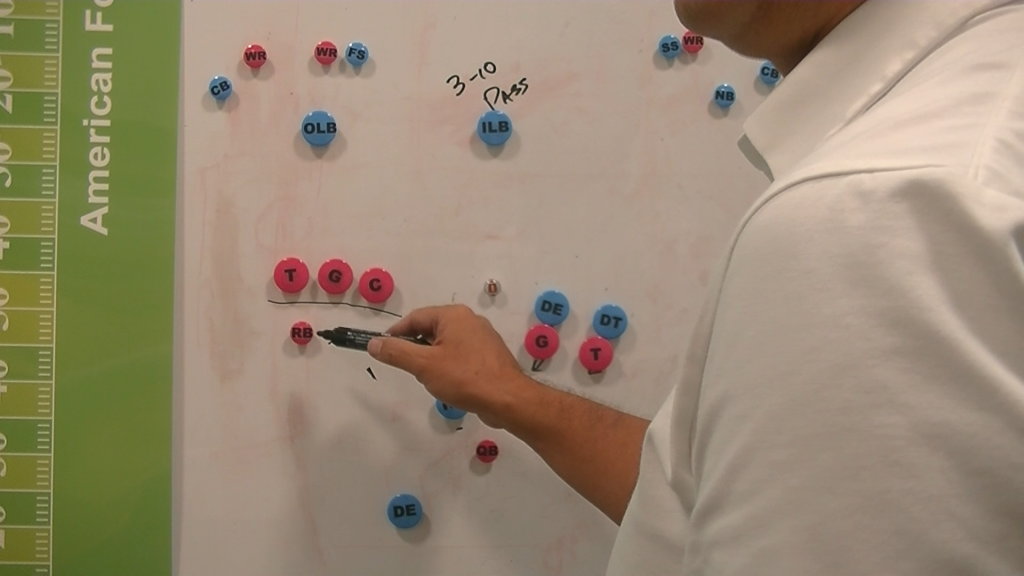
Originally, Screen Play were to pass to RB, but now I will explain about those to pass to WR which have been increasing recently.
In Pass heavy situations, WR turns around here, pretending Pass to Deep zone, and throw a short pass. DL will rush under such situation, so just like any other Screen Play, these OF players become blockers and let WR run after catch.
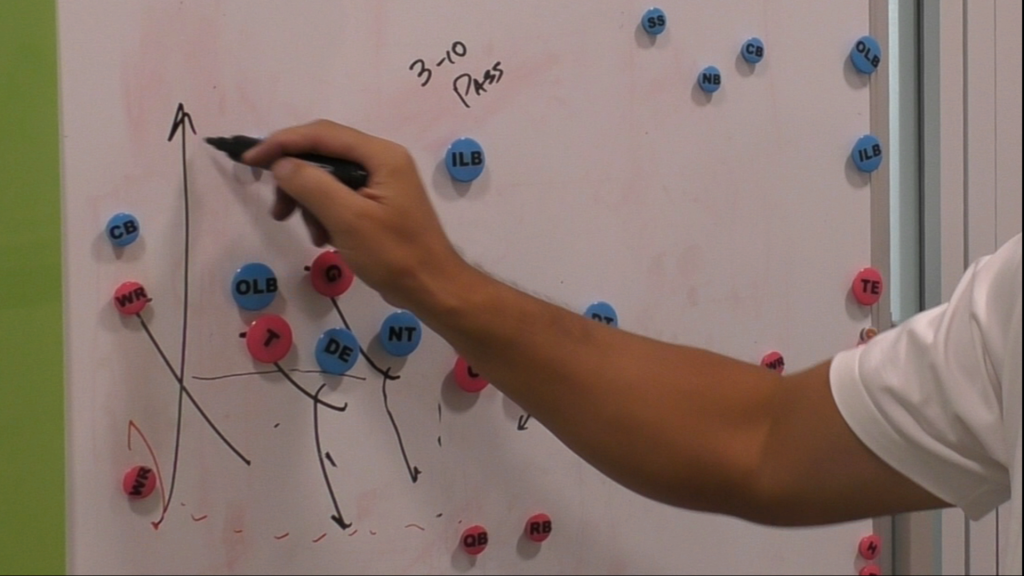
A play with a short pass to this side of Line of Scrimmage not only to RB, but also to WR, and then let the receiver run after the catch with Blockers is called “Screen Play”.
Some teams may prepare many types of Screen Plays.
For example, when DF players come in to Rush, this WR comes into the middle and a fluffy Pass is thrown to him. At this time, only 1 player is coming out of the middle and becomes a Blocker and blocks like this.
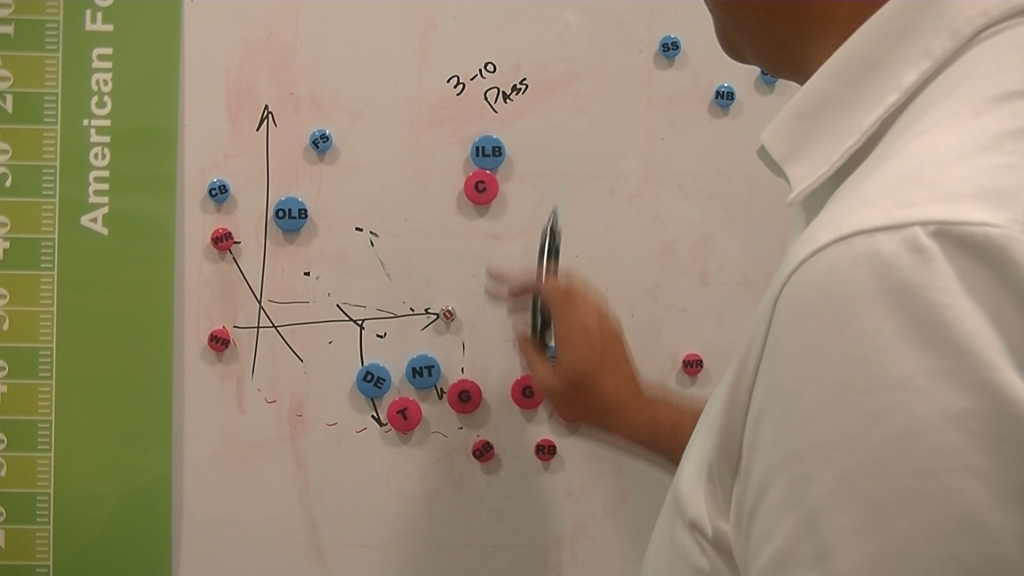
This is a distinctive Screen Play in the middle area.
Major play of Offense (OF) ② (Option)
The recent trend is to dare not block this DF player and if this player chases RB, QB will not hand him the ball and run himself. If DF player comes to QB, let RB carry the ball. This play is called “Option”.
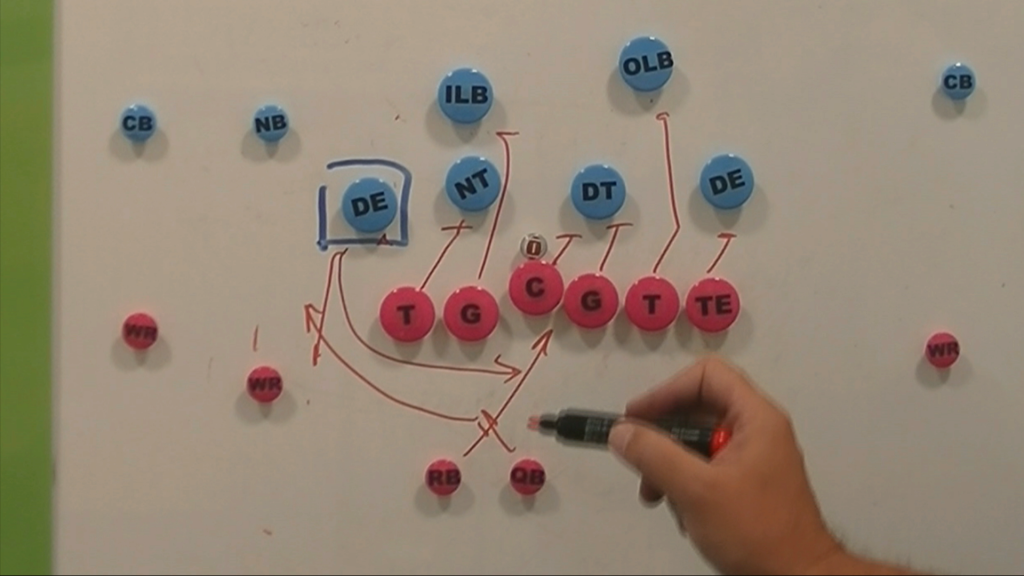
So it is possible to decide whether to hand the ball to RB or run by QB himself by watching the movement of this DF player.
Major play of Offense (OF) ③ (Run Pass Option)
Let me introduce “Run Pass Option.” It is commonly referred to as RPO.
When OL and TE plan to do Inside Zone and OF has 6 blockers against 6 DF players including this player (OLB), therefore, both number of players are the same. And if both number of players are the same, OF takes advantage.
I mentioned that “Option” is to watch this player’s (DE’s) movement and decide whether to hand the ball or to run by QB himself. This is the “R” in “RPO,” Run.
Now, let’s make another player’s movement a factor in the decision. If this player (OLB) reacts to Run Play and moves like this, this area will be favored by OF with 2 OF players against 1 DF player. If so, let WR run for 5 yards. Think about it, if this player (DE) is chasing RB and this player (OLB) also respond to Run Play like this, this side area will be open and OF takes an advantage by 2 WR to 1 CB, therefore, QB can easily throw a pass to WR to gain 5 yard, even if he was assuming that he will not hand the ball to RB and that run himself.
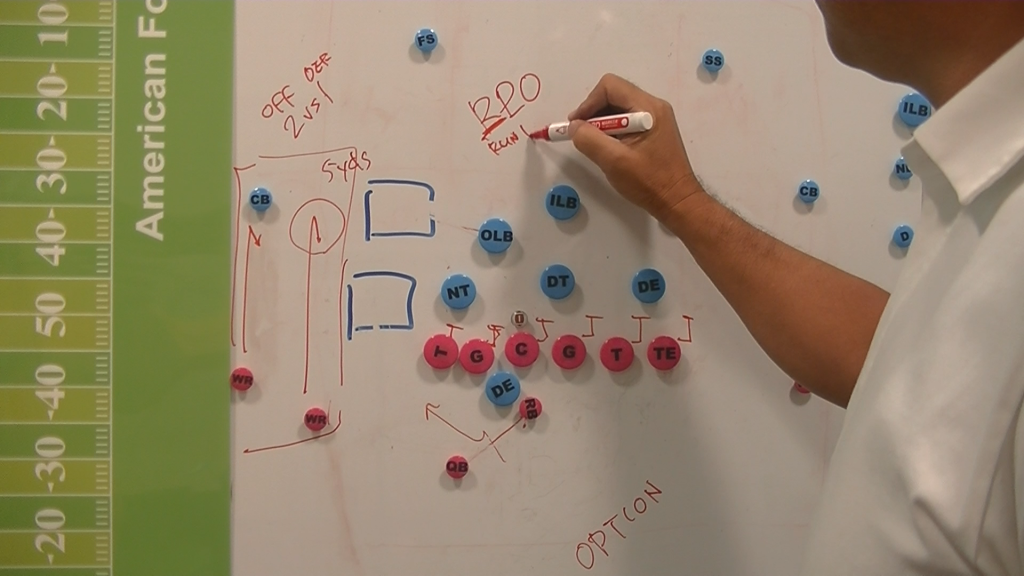
This selection is P of RPO, i.e., Pass, and such plays is called “Run Pass Option (RPO)” and is a recent trend.
Conversely, once this play is implemented, this player (OLB) will not react to Run Play next time from that memory. When such situation happens, and when this player (DE) is also marking the QB in addition, if QB hands the ball to RB and this area will be absolutely advantageous with 6 OF vs. 5 DF.
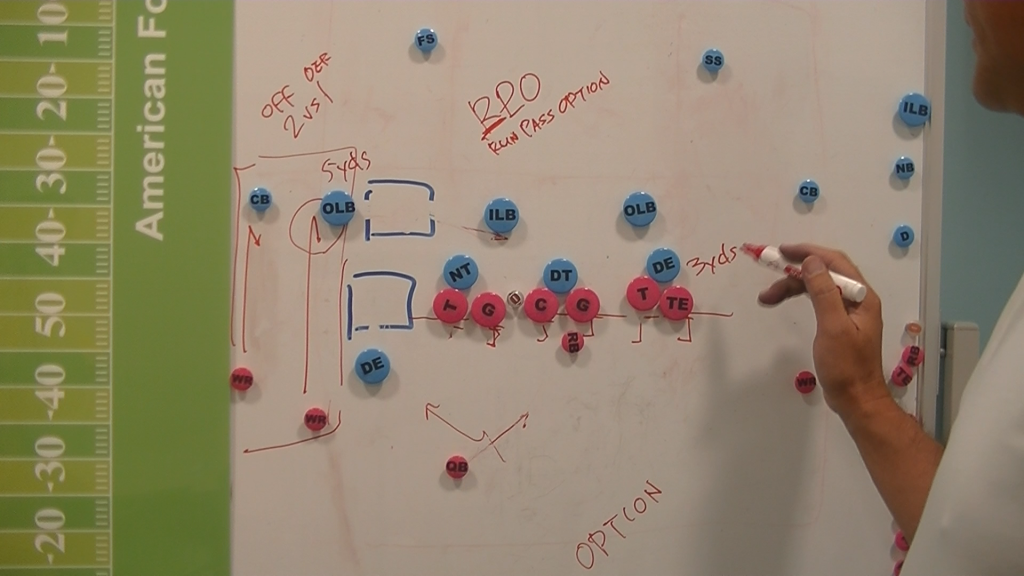
So, as “Run Play can be done,” “Pass Play can be done,” and “both play can be chosen at every time”, Run Pass Option is very trend recently.
Part3-2 How Offense (OF) thinks about Pass Plays
How to think about Pass Routes
What is the situation to avoid mostly for Defensive (DF) players, especially those called Defensive Backs (DB), which are Corner Back (CB), Free Safety (FS), Strong Safety (SS), as well as Nickel Back (NB)?
Q:Is it to have the opponent enter behind them?
That is definitely true. It is especially important to avoid because when OF players come into behind DB and if Quarterback (QB) passes to them, it will lead directly to Touchdown (TD).
There is an American Football tactic called “4 Verticals,” in which 4 players run in a straight line to Deep zone.

In American football, Receivers are to run into 4 areas which divide the field vertically by Hash Marks and the center, and it makes QB easy to complete Pass by throwing to the best match-up among them.
And since DB do not want OF to get in behind them, they often back anyway like this. For recent 10 years or so, if DB back deeply, OF makes Receivers stop or makes QB throw a pass towards the Receiver’s back intentionally.

If all DB are set up close to the Line of Scrimmage and show their will to defend hard by 1-on-1, it would be effective to let WR run to Deep zone and to throw to the best match up. If DB do not want to be got behind them by Receivers and therefore back down, then stop the Receiver like this.
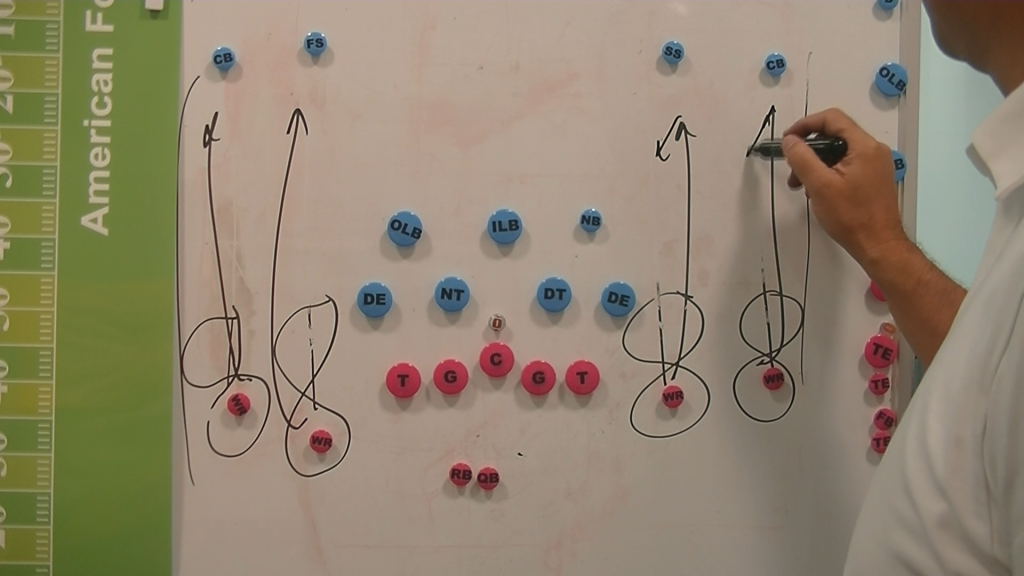
Now, I will introduce some examples of typical Pass Routes. This is called “Hitch,” Pass Route in which Receiver runs about 5 paces (6 yards) from the Line of Scrimmage and turns.
-1024x576.png)
This is “Hook,” the basic route done by many teams including high school. 12 yards, 7 paces.
-1024x576.png)
And, here is a route in which Receiver runs 9 paces, called “Long Hook,” 16 to 17 yards.
-1024x576.png)
And to run straight to Deep zone is called “Vertical”.
-1024x576.png)
Then, thinking about the straight Pass Route even for 1 WR, there would be 5 basic patterns including “Screen” where such WR stays in place.
Since there are many patterns of straight Routes alone, there are thousands of possible Pass Routes, including, for example, crossing 2 WR, having them both turn outside or inside, or even having one run inside and the other outside, and other such combinations.

OF is scouting and studying how DF will play, taking into account height, speed, quickness and technique, Down & Distance, field position, etc.
Conversely, from DF’s point of view, as OF is often playing this Pass Play in this situation, they often “sow the seeds.” In other words, WR and DB are cheating each other, such as DB prepares to return immediately pretending to drop back deeply, or pretending to cover tight but dropping back just before Snap.
Effects of unbalanced formations
When WR set unbalance, “4 Verticals” want to divide the field into 4 sections, so WR runs this way.

In this case, as this player has these various possible Pass Routes and this DF player decides to drop back for safety, it is good to let Receiver catch Pass here.

Just to change the balance, there would be 2 options, either place S exactly in front of each WR, or place them evenly against the field to prepare for Run plays to this side of the field.
Depending on this alignment, for example, if S sets here, Route across the field like this is effective, and if S sets here, hooking here is effective. Thus, OF may change the target depending on what kind of balance and alignment of DF.
Q: Does OF predetermine the target to throw a pass at?
Against Zone Defense, it is standard for OF to have 2 Receivers in 1 zone. QB watches DB in charge of such zone, which Receiver he marks, and decides to pass to the other Receiver.
If DF takes man-to-man Defense, QB would see the matchups of WR and DB when they set up and decide where to throw in most case.
If OF wants to cross these WR each other, it will take time to reach the planned position, so they consider whether Pass Protection will hold enough. If DF has a strong player among DL, like Mr. Aaron Donald, and OL cannot hold Pass Protection even if they take him by Double Team, then OF decides that they cannot secure time to let WR cross each other.

To consider what is the best choice, taking into account various situations such as matchups in the field and DF alignments, or whether the prior Scouting and today’s game plan are the same or not, is the role of Offensive Coordinator (OC) and QB.
Share this content:

コメントを残す